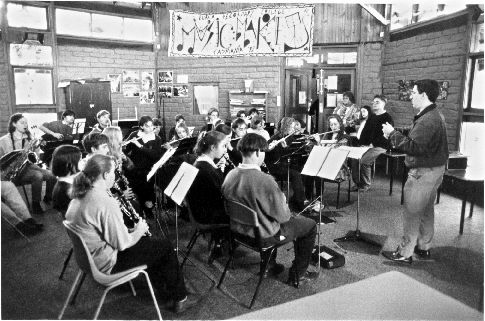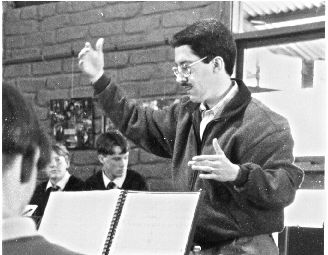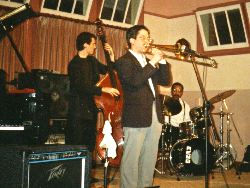Fostering Jazz Education In Rural Australia
by Susan McLean
The fostering of improvisation and jazz studies is a significant challenge in rural Australian schools. Isolation can be a real barrier and cultural horizons quite parochial. Opportunity to listen to professional musicians communicating in that very special way unique to jazz is rare. Students in the country, while highly motivated in the sports arenas, are on the whole not accustomed to being expressive individuals, to speaking out, to taking creative risks. In one Australian country town, staff of a secondary school have embarked on some formidable arts initiatives over recent years, resulting in an environment supportive of individual creativity and some noteworthy adventures into jazz education.
In June 1996 Jazz Australia honoured the town of Euroa with IAJE financial support (via funds designated for "underserved schools and communities") towards a visit by one of JA's guest international tutors, Antonio García. Jazz Australia is an annual event in conjunction with the Australasian IAJE Conference at Western Australia's Edith Cowan University in Perth. García's visit to Euroa–in North Eastern Victoria, some 3500 kilometers (2170 miles) away from the city of Perth–represented recognition by IAJE and Jazz Australia of an earned reputation for significant jazz enthusiasm on the part of this town. [For a related article, please see "Jazz Australia '96" by Antonio J. García.]
Euroa is a small country town with a population of 2800; and while Tony conducted jazz workshops there, he witnessed first-hand the unique ways in which this rural secondary school has attempted to overcome a few of the hurdles in front of creativity in education–particularly jazz education.
The Mud Brick Music Room
The music room at Euroa Secondary College provides an ambient environment where creativity and inspiration are obviously valued. The Mud Brick Music Room, completed in 1989, involved teachers, parents, students, and the whole community, taking three years to build from soil dug out of the local hills. Artists-in-residence were involved as well; and with its beautiful leadlight windows, this room is clear indication of community support for the arts, for creativity, for music. The windows depict endangered wildflowers species of the Euroa area.
 |
Antonio García rehearses concert band students in the Mud Brick Music Room of Euroa Secondary College on an an arrangement of 'Round Midnight. Photo credit: courtesy Euroa Secondary College |
Artists-in-Residence
Artists in both the performing and visual arts have been welcomed in this particular school on several occasions. Here young people have been nourished with role models of exceptional talent and imagination. Each residency has aimed at enrichment of the cultural experiences of the students with whom the teachers are daily involved.
Jazz Connections Implanted
A fairly strong affiliation of jazz musicians with Euroa resulted from a chance visit to the mud brick building site around 1988 by bassist Belinda Moody and some friends–who were at that time music students of the Victorian College of the Arts in Melbourne (two hours' drive away). For a few years, Belinda made regular visits to Euroa, bringing with her friends from the jazz ranks of Melbourne, enthusiastic to share their passion for jazz with young musicians.
Tell Me About The Blues
Improvisation was introduced in a project called "Tell Me About The Blues" in 1993. A blues guitarist, Paul Wookey, was the Artist-in-Schools in the Euroa district: he reached nearly three hundred students a week, visiting eight schools over a twenty-two-day period. The smallest of these schools had an enrollment of fourteen students; and many were well into the hills of the Strathbogie Ranges–"Ned Kelly" (bushranger) country.
A "Different Feel"
A significant challenge for Wookey was the cultivation of the "feel" or swing of blues, with emphasis on the second and the forth beats. This rhythm, while inherent to the blues, is not within the usual repertoire of Australian music education because of the direction from which music is generally approached in schools: classical, brass, and concert band traditions. Wookey workshopped students and music teachers in the musical form of the blues. He sang and played guitar in a range of blues styles and demonstrated the many sounds of the acoustic and electric guitar: from the polyphonic styles of the early blues guitarists to delta blues and the more modern expression of Hendrix and Clapton. Paul lured improvisations from young recorder players five to twelve years old and chord and rhythm management from guitarists. He emphasised to the thirteen to seventeen year-olds the importance of musicians listening to each other and making improvisation work in the same manner as a personal conversation; and he encouraged some less-confident students to take musical risks.
The Mud Brick Music Room has witnessed two short visits by the ubiquitous Melbourne jazz pianist Bob Sedergreen, who has contributed to a steady increase in the understanding of the rules of improvisation, showing students the "safety net." Teachers at Euroa have been encouraged to place more faith in the musical ear of the young people with whom they deal, occasionally putting aside their reliance on sheet music, instead encouraging personal exploration of the instrument.
Don Burrows Residency
The summer of 1995 (December in Australia) saw the beginnings of an association with legendary Australian saxophonist Don Burrows. "Summer Cool with Don Burrows" presented an extraordinary and prestigious arts event for Euroa: a week of jazz education conducted by Burrows and guitarist George Golla. Burrows' receipt of an Australian Creative Fellowship in 1995 enables him to continue the outstanding work he has been doing over the last fifteen years in school-based jazz education.
Burrows awakened an enthusiasm for music. In stage band, concert band, and small group combinations, he explored the relevance of both group and individual voices. Don regularly reminded students to listen to themselves, to one another, and to the great jazz musicians of the twentieth century: "The two best teachers in the world are on either side of your head."
Day of Jazz
Jazz clinics take the mystery out of improvisation. A day of such clinics in our "Summer Cool" program brought two hundred and seven students from twenty-five different schools together for workshops. Fifteen professional jazz musicians were employed, largely from Melbourne. The program, in eight different venues, offered a wide range of jazz themes: "The Role of Guitar in Various Jazz Styles," "Rhythm Section Workshop," "Gospel to Jazz" (presented in a church), "Learning Familiar Standards and Taking Solos" (for front-line instrumentalists), "Piano Clinics," "Contemporary Funk," "Reeds and Flute Workshops."
Musicians who tutored the clinics throughout the day all demonstrated very sophisticated musical knowledge, an absolute passion for their music, and shared generously with students. Students gained an appreciation that improvisation is not "rampant creativity": there are rules, guidelines–and that self-expression, instrumental, and music skills can be learnt and improved upon. A public concert presented an opportunity for one hundred and thirty students, who in various combinations were assisted by Burrows and Golla to perform their musical achievements from the week. The concert demonstrated the wonderful strength of jazz music to uplift the spirits of performers and audience alike.
Community Enthusiasm
The parents of the students involved keenly expressed their enthusiasm for what transpired; and this, along with student and teacher responses, has gone some considerable way in the establishment of jazz as a valid and popular ingredient in the education of these young people, extending the potential of the arts. With the Australian Creative Fellowship being awarded to Don Burrows for five years, Euroa has been targeted for ongoing involvement in his residencies. Our vision is for a youth jazz festival, which would encourage groups to prepare and perform as well as attend workshops and master classes.
Student Bands in Euroa
Euroa Secondary College has a fairly impressive stage band, "Pzazz": the number of participating students has been steadily growing, with about eighteen currently participating. Count Basie and Duke Ellington are the popular choices in their repertoire.
Students also formed a modern jazz quartet which plays familiar standards as well as their own arrangements of compositions by such great musicians as Thelonious Monk, Miles Davis, John Coltrane, Don Pullen, and Keith Jarrett. This group, the Day-McLean Quartet, has chosen music of a minority genre, in strong contrast to the music consumed by most other young people. Their method of learning has been almost entirely aural; and while they have been largely self-motivated and self-managed (with very little adult input), the visits by notable professional jazz musicians to the school over the years have obviously played a very positive role.
Since these young "musos" (musicians) began rehearsing every Friday in the Mud Brick Music Room, they have developed something fairly unique with their music. They listen ardently to live and recorded jazz, including some of Australia's most accomplished musicians: Mike Nock, Bob Sedergreen, Graeme Lyall, Paul Grabowsky, Dale Barlow, David Jones, and Roger Frampton have offered their valued advice to the young musicians in jazz workshops. Traveling considerable distances to attend jazz master classes throughout Australia, these boys (the youngest 14, the other three 18 this year) have learned the jazz language from such international visitors as Rufus Reid, Akira Tana, Dr. Willie Hill, Jimmy Cobb, McCoy Tyner, and more recently Lee Konitz. They have discussed their passion for jazz over coffee with Nat Adderley. The Day-McLean Quartet has been presented in 1994, '95, and '96 at two of Australia's most prestigious jazz festivals: Montsalvat and Wangaratta.
A brave precedence was determined in January 1996: the inclusion of the words "jazz" and "practising musician" in the job description of a new instrumental teacher for Euroa Secondary College. This resulted in the employment of Tim Wilson, a recent graduate from the improvisation course of the Victorian College of the Arts. The addition of such a specialist has been popular with students and has seen the rise of a funk band, "Alchemy," and an enthusiasm for jazz. It is significant that two of these student groups–the modern jazz quartet and the funk band–have received invitations to play at the Wangaratta International Festival of Jazz and Blues in November '96.
IAJE & Antonio García
 |
Antonio García rehearses the Euroa Secondary College Concert Band Photo credit: courtesy Euroa Secondary College |
The involvement of IAJE in the visit to this small country town by Antonio García has given authority to the creative aspirations of the staff at Euroa Secondary College. Tony worked with the young concert band musicians on an arrangement of "Round Midnight," exploring the interpretation of the written music as well as the underlying rhythmic and melodic traditions of jazz within it.
In the workshops that followed with the students of Euroa and neighboring Goulburn Valley, he focused solely on jazz techniques, examining a range of topics including "rhythmic attitude," chord tones, call-and-response exercises, and the use of Aebersold play-along recordings. Tony's approach to "Making Wrong Notes Right" gave a new insight and projected fun into the possibilities of improvisation–and the courage to take a risk. His technique of leading the students through the vocal learning of a Miles Davis solo was appreciated by them. Most had probably never even heard of Miles before; yet in about fifteen minutes those young people had learnt more about the unique characteristics, the simplicity of phrasing, spaces between, motivic development, repetition of melody, and haunting tones of Davis' music than any written text could ever impart to them.
Euroa: Rural Rarity
This picture of Euroa Secondary College is probably fairly unique in rural Victoria. In a time when much is debated about the issues of teaching and learning strategies afforded to young people, curriculum support material has been recently published for the arts encouraging "right-brain" creativity, with a focus (specifically for music) on jazz. Few rural schools, however, have more than a passing acknowledgment of jazz: in some instances there remains an obsession with virtuosity and the literal interpretation of the score–and an aversion to improvisation, to "swing," and to individual expression.
Risk as Learning
The appeal of swing does not come naturally to music teachers who have a classical background; and there is a certain safety net offered by rehearsal, sheet music, predictability, and more rehearsal. Please, no foot tapping! Unfortunately for some students, musical "fitness" holds more importance than musical expression.
Practising jazz musicians as artists-in-residence can assure teachers that the encouragement of students in the use of their instruments to make personal statements need not be threatening. They have demonstrated that an imaginative "lateral" approach–with a balance between right-brain, creative activities and logical, learned notation–pays off with quicker instrumental facility and growth of musicianship.
 |
Antonio García performs with local musicians at the end of his Euroa residency |
This school has witnessed a preparedness on the part of some tutors to relinquish "control," to encourage personal expression of a solo at the risk of hearing something not quite right: a tradeoff for growth in the creative process. While working at Euroa Secondary College, Antonio García enthusiastically involved students in making up musical ideas via the call-and-response style. At times it was risky; but conducted in a supportive environment, it was indeed fun for the students. Experiences at Euroa would seem to indicate that students are enthusiastic about an aural approach to learning. Jazz tutors have demonstrated that where students are empowered with improvisation, there is likely to be more spiritual involvement, communication, and enthusiasm.
Even in this school, however, whilst jazz education has gathered strength over the years, it is "not all roses"; and there has been a percentage of young Euroa musicians who have always been more comfortable with the sheet music to follow. Some "freeze" when asked to interpret a scale in their own way, and some choose not to enroll when visiting musicians are offered. These fears might be gradually overcome by the workshops and by increasing the opportunities for jazz listening, particularly for those whose experience has never included jazz or the blues.
Uniting through Jazz
Most of the workshops and residencies have concluded with an evening of fine jazz at the Euroa Schoolhouse Community Arts Centre; and the youth audience (admitted free) is steadily growing. A creative approach at Euroa Secondary College and appreciation of right-brain functioning and risk-taking have led to some new youngjazz fans–and a unique situation for jazz education in country Au stralia. We applaud the generosity of spirit of the fantastic jazz musicians who have contributed to our community's artistic expression.
Susan McLean is the Arts Coordinator at Euroa Secondary College in Victoria, Australia. The Arts program encompasses both the Visual and the Performing Arts; and she teaches Art, Graphic Communication, Computer-Aided Graphics, Photography, and other related subjects. The motivating force behind the artist-in-residence programs at Euroa Secondary College, she is currently the Artistic Director for the five-year residency program, which involves the Don Burrows Australian Creative Fellowship. Susan is a practicing artist; and her paintings, drawings, and textiles have been exhibited throughout Australia and in Toronto, Canada. She is President of the Euroa and District Arts Councils and serves on the Australasian Committee of IAJE. Jazz is a family affair, with Susan and husband Geoff strong supporters for their young sons Dustin (piano) and Lachlan (alto and soprano saxophones), two members of the Day-McLean Quartet.